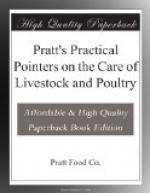You may not appreciate the value of using such a conditioner, but the Kentucky Agr. Exp. Station, in Bulletin 181, contains the following statement which deserves the careful consideration of every thoughtful hog raiser: "General conditioners have been found to be advantageous in the maintenance of healthy conditions in hogs.”
Brood sows should not produce their first litter under twelve months. Whether they should produce one or two litters a year will depend largely upon the conditions, especially of climate. Sows should be kept for breeding as long as they will produce good, even litters. Well-chosen sows should rear an average of eight to the litter.
Brood sows should have ample exercise. They get it in good form when they are allowed to turn over litter in the barnyard on which a little grain, as corn, has previously been sprinkled. Two-thirds of the winter rations may consist of mangels or alfalfa hay—the other third being grain or swill. Alfalfa for hogs should be cut before blossoming.
When sows farrow they should be fed lightly for the first three days. Later give all they will eat of milk-making foods. A combination of ground oats, wheat shorts, and some corn is excellent. And Pratts Hog Tonic will be found especially valuable during the nursing period. Meal is fed ground and soaked. As soon as young pigs will take skim-milk they should get it in a trough apart from the sow. They are weaned at seven or eight weeks where two litters are grown in a year, and at twelve weeks where but one is grown.
When pigs are weaned, and previously, there is nothing better than shorts and skim milk. They should be grown subsequently to weaning on pasture, with one to two pounds of grain added daily. In season, winter or spring rye, clover, alfalfa, barley, and rape all make excellent pasture.
The fattening period with swine covers from six to eight weeks. Unground corn and water will fatten swine in good form. The same is true of barley and rye, ground and soaked. They may be fattened nicely while grazing on field peas. They may also be similarly fattened by hogging off corn or gathering it from the excrement of cattle that are being fattened on it. Swine well grown should make an average gain of a pound a day. Bacon swine may be best sold at 175 to 200 pounds in weight. Lard types are usually grown to greater weights.
Swine breeders have long recognized the value of Pratts Hog Tonic as a disease preventive and fattener. Progressive breeders now consider it a necessity in profitable hog raising.
If a second litter is wanted during a year the sows should be put to the boar during the first heat after weaning. Many breeders do not like to pass periods of heat for fear that the sows may become “shy,” and there is little reason why a sow should not have two litters a year. In any case, the sows should be carried on comparatively light feed until time to breed again, gaining a little in weight; and their treatment after breeding should be as already detailed for pregnant sows.




